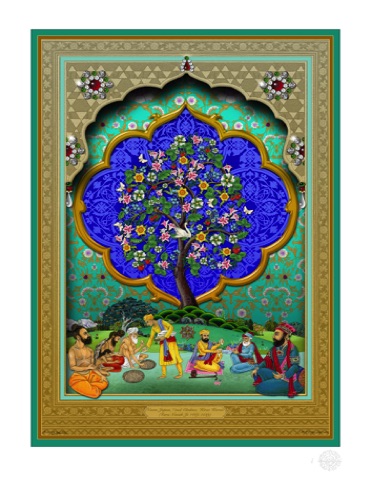BUY / COMMISSION
ORIGINAL ARTWORK
UK ORDERS
SHOP > COLLECTORS PRINTS > Fine Art Giclée Print > Un-Signed Open Edition > Naam Jap, Vand Chakna, Kirat Karna
Naam Jap, Vand Chakna, Kirat Karna
20 INCH FINE ART GICLÉE PRINT
Un-Signed Open Edition
EUROPE ORDERS
REST OF WORLD ORDERS
£303.95 (+ VAT)
£310.90
£322.00
PLEASE ORDER ACCORDING TO YOUR DELIVERY ADDRESS
Price Includes Delivery - excluding any import duties that may be applicable for orders outside UK. Please see 'DELIVERY INFORMATION' below.*

20 INCH FINE ART GICLÉE PRINT
Product Details
Image Size: 20 x 28.39 inch (508 x 721mm)
Paper Size: 24 x 33.4 inch (609.6 x 848 mm)
Product Description
ARTIST SIGNED & NUMBERED EDITION
❋ Image size - 20 Inches (on the smallest dimension)
❋ Printed on 100% cotton, acid free, paper with proven UV stable, archival quality, pigment inks for absolute light-fast quality and long durability.
❋ Bears 'The Singh Twins’ authorisation emboss mark
❋ Comes with artists' hand-signed Certificate of Authenticity.
Product ID: GC20_U-Naam Jap
❋ Print is un-mounted and un-framed
ARTWORK SUMMARY
Naam Jap, Vand Chakna, Kirat Karna
This artwork represents the core teachings of Guru Nanak Ji (founder of the Sikh Faith) popularly known as: 'The Three Golden Rules'. Namely, Naam Jap - (remembrance of God in all that we do), Vand Chakna (sharing to uplift others) and Kirat Karna (honest or truthful living).
These principles of daily living are symbolised by a tree composed of forget-me-nots
(for remembrance), daffodils and stargazer lilies (denoting honesty, truth and open-ness) and strawberries (representing a life of good deeds) in plant symbolism. Within its branches we see a white swan (symbol of the pure soul in Sikhism) and moths (symbolising determination and faith in animal symbolism). Together, they point to how faithfully striving to adhere to the 'three golden rules' leads to spiritual enlightenment.
Imagery beneath the tree, illustrates how the concepts of Vand Chakna and Kirat Karna relate to stories from Guru Nanak's own life. One of these tells how as a young boy, Nanak was instructed by his father to go out and make a good business investment. Nanak bought food for some starving holy men whom he met during his journey. When reprimanded by his father for wasting the money, Guru Nanak explained that there could be no better bargain or deal than feeding the hungry. The second story relates to the time when, during his travels in later life, Guru Nanak Ji stopped at a village and chose to accept an invitation to eat at the home of a poor carpenter named Bhai Lalo instead of the home of a wealthy man called Malik Bhago. When the enraged Malik asked Guru Nanak Ji why he had chosen Lalo's simple, coarse food over the lavish feast he had prepared, Guru Nanak asked for bread from Lalo and a piece of rich food from Malik. He squeezed the bread in one hand and the rich food in the other. The former dripped with milk, whilst the latter dripped blood. Guru Nanak explained that this was because Lalo's bread was the product of hard work and honest living whilst Malik’s food had been earned at the expense of others. Malik realised the error of his ways and from then on changed his life.The imagery for both stories draws on earliest artistic representations of Guru Nanak as well as descriptions and iconography established in the popular Sikh oral and later illustrated manuscript narrations or janam sakhi tradition pertaining to his life.
An eight pointed star (a symbol of wealth) surmounted by a jewel (symbol of God's name in Sikhism) represents the spiritual 'wealth' that comes from remembering the Divine in daily life in accordance with Naam Jap. The circular arabesque pattern behind the tree denotes the eternal cycle of birth and rebirth which can be broken by faithfully following the 'Three Golden Rules'. Guru Nanak's message of universal love as the foundation of all his teachings and a path to enlightenment, is represented by the pattern of coriander flowers on the aqua blue background: where coriander is associated with love in plant symbolism, and aqua blue, the colour of spiritual healing.